CPR drops to 47.0 percent in 2000
The contraceptive prevalence rate (CPR) or the proportion of married women 15-49 years reporting current use of contraceptives drops to 47.0 percent in 2000 from the 49.3 percent recorded in 1999 (Figure 1). This is primarily caused by the decrease in the use of traditional methods (16.9% to 14.7%), particularly withdrawal (6.7% to 4.8%). Meanwhile, the prevalence rate of modern methods leveled off in the last two years (32.4% in 1999 and 32.3% in 2000).
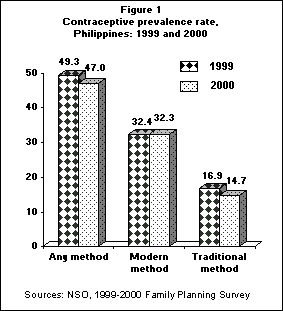
Family Planning Survey (FPS) results from 1995 to 2000 reveal a decline in the CPR, from 50.7 percent in 1995 to 47.0 percent in 2000. The same rate of contraceptive use was recorded in the 1997 FPS and in the 1998 National Demographic and Health Survey (NDHS). The 1999 FPS estimate for the CPR (49.3%) was a marked improvement, particularly the prevalence rate of modern methods (from 28.2% in 1998 to 32.4% in 1999) (Table 1).
Table 1. Contraceptive prevalence rate, Philippines: 1995-2000
| Year | Any Method | Modern Method | Traditional Method |
| 1995 | 50.7 | 25.5 | 25.2 |
| 1996 | 48.1 | 30.2 | 17.9 |
| 1997 | 47.0 | 30.9 | 16.1 |
| 1998* | 46.5 | 28.2 | 18.3 |
| 1999 | 49.3 | 32.4 | 16.9 |
| 2000 | 47.0 | 32.3 | 14.7 |
*Based from the 1998 National Demographic and Health Survey, which used a different sampling design.
Sources: NSO, 1995-1997, 1999-2000 Family Planning Survey
NSO, 1998 National Demographic and Health Survey
Pill remains the most popular method
The pill remains as the most popular contraceptive method among married women 15 to 49 years old with 13.7 percent using this method in 2000 (Figure 2).
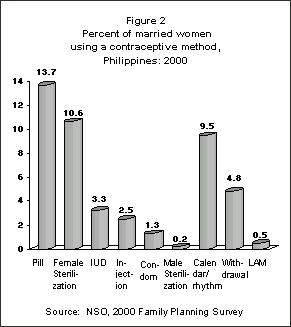
Female sterilization ranks second with a prevalence rate of 10.6 percent, followed by calendar/rhythm with 9.5 percent. Withdrawal method is used by 4.8 percent, IUD by 3.3 percent and injection by 2.5 percent. Only 1.3 percent of women use condom and less than 1 percent use Lactational Amenorrhea Method (LAM) or male sterilization.
For the four FPS survey years in 1996, 1997, 1999 and 2000, the pill was the most commonly used contraceptive method. Female sterilization and calendar/rhythm were consistently the second and third most widely used method, respectively (Table 2).
Table 2. Contraceptive prevalence rate for selected methods, Philippines: 1995-2000
| Survey Round | Pill | Female sterilization | Calendar/rhythm |
| 1995 | 11.2 | 8.9 | 18.4 |
| 1996 | 11.6 | 10.6 | 10.3 |
| 1997 | 12.5 | 10.6 | 9.7 |
| 1998* | 9.9 | 10.3 | 8.7 |
| 1999 | 13.1 | 10.7 | 9.6 |
| 2000 | 13.7 | 10.6 | 9.5 |
*Based from the 1998 National Demographic and Health Survey, which used a different sampling design.
Sources: NSO, 1995-1997, 1999-2000 Family Planning Survey
NSO, 1998 National Demographic and Health Survey
In the 1998 NDHS, female sterilization (10.3%) was reported as the most popular contraceptive method. The pill (9.9%) was the next most popular method followed by withdrawal (8.9%) and calendar rhythm (8.7%).
The pill (11.2%) and female sterilization (8.9%) were recorded as the second and third most preferred method, respectively in the 1995 FPS.
Cagayan Valley has the highest CPR
Cagayan Valley has the highest CPR at 61.2 percent, while the Autonomous Region in Muslim Mindanao (ARMM) has the lowest at 12.6 percent (Table 4).
The prevalence rate for the pill is notably higher in Cagayan Valley (24.2%), and Western Mindanao (19.1%) than in any other regions (Table 4). Female sterilization is more widely used in Central Luzon (18.0%), Cagayan Valley (14.9%) and Metro Manila (14.5%). The calendar/rhythm method is more popular in the Visayas and Mindanao regions (except for ARMM) than in Luzon.
Contraceptive use is higher in urban areas than in rural areas
The use of contraceptives is more prevalent in urban areas (48.6%) than in rural areas (45.5%) (Table 4 and Figure 3). This is mainly due to the higher prevalence of female sterilization in urban areas than in rural areas (12.9% versus 8.5%). On the contrary, more rural women (3.1%) prefer the use of injection than urban women (1.9%).
Contraceptive use peaks at ages 35 to 39 years
Contraceptive use among married women peaks at ages 35 to 39 years (54.4%) and is lowest at ages 15 to 19 years (22.9%). About one-third (34.4%) of those in the oldest age group (45 to 49 years) report using a family planning method (Table 3).
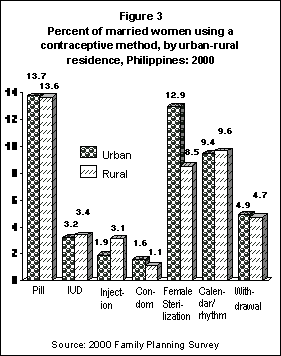
The most commonly used methods by younger women differ from those preferred by older women. Women below 40 years old prefer to take the pill than to undergo female sterilization or use the calendar/rhythm method. On the contrary, those who are 40 years and older prefer female sterilization and calendar/rhythm method than the pill.
Half of the women had sterilization operation at age below 30 years
The median age for female sterilization for year 2000 is 29.9 years (Table 6). This means that half of the women who have been ligated had the operation when they were below 30 years old. This median age is lower than that in 1996 (30.1 years) and 1999 (31.3 years), and equals that in 1997 (29.9 years).
CPR is highest among women with three children
Married women with three children have the highest CPR (57.9%), followed closely by those with four children (57.6%). As expected, childless women have the lowest CPR (3.9 %).
The pill is most preferred by women with one to two children (13.9 and 20.0 percent, respectively); and female sterilization, by women with three to six children (16.8, 17.8, 15.6, and 13.3 percent, respectively). Women with seven or more children prefer calendar/rhythm method (9.5 percent) over female sterilization (8.1 percent) and pill (6.8 percent) (Table 4).
Women in poor households are less likely to practice family planning
Five out of 10 (50.2%) women in non-poor households use a family planning method as compared to only four out of 10 women in poor households (40.1%) (Table 5 and Figure 4).
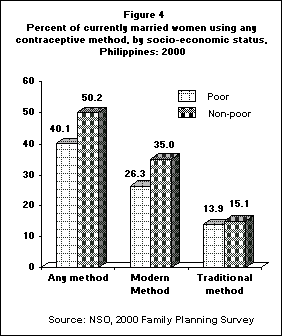
The pill is the most preferred contraceptive method for both poor (13.3%) and non-poor women (13.8%). Female sterilization is the second most preferred method among the non-poor women (13.2%) while it is calendar rhythm among poor women (9.4%). Female sterilization is used by only 5.1 percent of women in poor households.
The public sector is the major source of modern contraceptive methods.
The public sector is the major source of modern contraceptives (Table 7 and Figure 5). Three out of four women (73.7 %) currently using a modern contraceptive method obtain their supplies from the public sector. In contrast, only one out of four women (24.7%) obtain her supply from a private source.
Government hospitals (25.4%), rural health units/urban health centers (26.5%) and barangay health stations (19.6%) are the leading sources of supply within the public sector. Only 2.2 percent of women obtain their supplies from the barangay service point officers/health workers.
The private sector, wherein the pharmacies and private hospitals/clinics are the more popular sources, provides supplies to almost a quarter (24.7%) of users of modern methods. In particular, 37.2 percent of condom users obtain their supply from pharmacies.
Moreover, three in ten men (30.7%) who have had vasectomy had their operation in private hospitals/clinics. One-fourth or 24.7 percent of the women who have been ligated had their operation also in private hospitals/clinics.
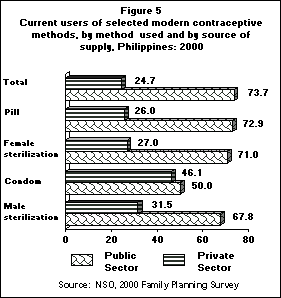
(Sgd.) CARMELITA N. ERICTA
Administrator
Background of the Survey
The 2000 Family Planning Survey (FPS) is a nationwide survey aimed at collecting information on contraceptive use in the Philippines in 2000. It is the fifth in a series of annual family planning surveys that the NSO has conducted from 1995 to 2000, with funding assistance from the United States Agency for International Development (USAID).
About 96 percent (44,209 of the 46,143 women) of the FPS eligible respondents nationwide 15 to 49 years old were successfully interviewed. Among the regions, Ilocos had the lowest response rate with 89.2 percent; while Caraga, ARMM, Northern Mindanao, Western Mindanao and Central Visayas had the highest with about 98 percent each.
In the 2000 FPS, each household was classified into poor or non-poor household based on the score that indicates the household's socio-economic standing. This score was calculated based on the responses in the FPS on the presence of housing conveniences/durable goods.
Note: For more detailed discussion on the 2000 FPS results, please refer to the 2000 Family Planning Survey Final Report which is available at the:
National Statistics Office
2nd Floor, Soledad Bldg., Ramon Magsaysay Blvd.,
Sta. Mesa, Manila
Tel. No. (632) 713-7081
